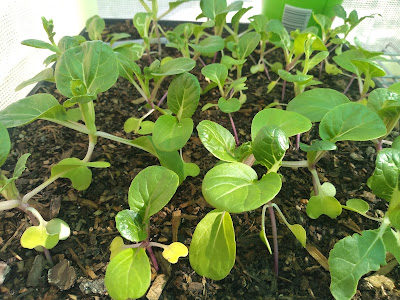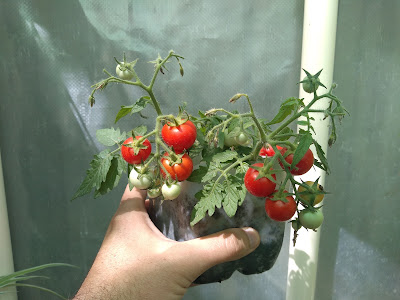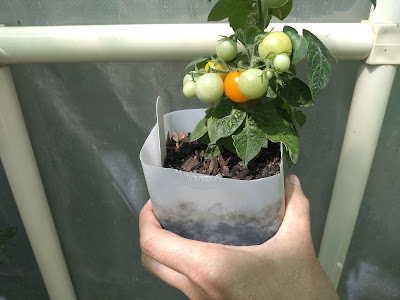I grow a lot of different vegetables, herbs, berries, and other fun things. I grow a lot of perennial vegetables, and also some annuals and biennials.
I have done a little breeding and produced some really enormous plants.
Massive vegetables are great if you have the space and have a large family to feed, but are not worth growing if you only have a balcony or a windowsill to grow your plants. If you have a small family, live on your own or only live with your partner, then smaller vegetables may be more suitable for you to grow.
I have also done some breeding of smaller vegetable plants such as Igloo tomato, Nanuq tomato, Immali corn, Oaken tomato, Tracey Tomato. Immali corn reaches about 5 feet tall, the tomatoes reach about one to two foot tall. While these are nowhere near the monstrous sizes that other varieties can reach, they are also not tiny.
I can also see the point of growing tiny vegetables (as well as breeding enormous vegetables, and smaller vegetables) so I have also started dabbling in breeding micro vegetables. Micro vegetables are nutritious and adorable, plus they take next to no room to grow. Micro vegetables won't feed your family, but they can be the difference between growing some food, or growing nothing.
 |
| Hedou bok choy and Micro Tom tomato |
Tiny micro dwarf vegetables are fun to grow. They take up next to no room, they produce nutritious wholesome organic food, they are ridiculously cute, they go from seed to harvest in a very small amount of time, and you can grow several crops each year. Being tiny means that you harvest what you will eat fresh that day, no need to store anything and no waste.
Micro vegetables can be grown by urban farmers with nothing more than a sunny window sill, some water, and a pot of dirt. If you can't find a pot, then cut off the base of a milk bottle, or use a yoghurt container, be creative! If it can hold soil, and has drainage holes, then it will probably work for micro vegetables.
Below are some photos of Micro Tom tomato, and Hedou Bok Choy. These are the tiniest varieties of each of these vegetables.
 |
| Micro Vegetables - nutritious, fast growing, and cute |
Hedou Bok Choy is adorable. It is tiny and cute and makes Baby Bok Choy look enormous. The ones in the photos are growing in a 10cm pot.
This is the size that these are normally harvested, but I am keeping these particular plants for seed saving. As you can see, they take up next to no room, could easily be grown under taller vegetables or other plants, and you harvest exactly as many as you plan to eat in that meal - making them super fresh.
There were five plants in that tiny pot, but one was culled as it did not meet my strict seed saving requirements. Five plants easily fit in such a tiny pot, I have a feeling I could have put in even more and they would have grown just as well.
 |
| Hedou Bok Choy - several plants in 10cm pot |
I have a seedling tray that was partly empty. Instead of having unused soil with nothing growing in it, I decided to plant out some Hedou bok choy.
In an area that was 25cm by 20cm I planted 30 Hedou bok choy plants. Six rows of five plants spaced relatively evenly apart.
 |
Hedou Micro Bok Choy almost ready to harvest
|
 |
| Hedou Bok Choy Flowering |
These could have been planted slightly closer if I wanted and they would have still thrived. That's the beauty of micro vegetables, they can be grown in impossibly small spaces and still produce fresh food.
They do need some depth of soil for root space. The Hedou Bok Choy that is in the small pot would have a depth of under 10cm for roots, this seems to be ample. You may notice that the plants in this pot have larger leaves.
The thirty plants were in a seed raising tray with about 3 or 4cm depth for roots, that did not seem enough and the plants bolted to flower pretty quickly. This early bolting may have been caused by the heat and fluctuating weather, but I suspect if they had a deeper pot they would have held off a little longer.
Early bolting is not the end of the world, I ate some of these plants, and kept the best ones to produce seed. You can eat the flower stems of bok choy, there are even some varieties that have been bred for that exact purpose.
 |
Micro Tom tomatoes ripening
|
 |
| Micro Tom plants flowering and fruiting |
Micro Tom is the smallest tomato variety ever produced. They don't produce the smallest fruit, they produce the smallest plants.
The plants below have grown under shade in my greenhouse and are much taller than normal. When grown in direct sun sometimes they barely reach 2 inches tall.
 |
| Micro Tom getting tall under low light |
My micro tom plants have grown to heights of between 4cm and 9cm tall. I have grown them in pots, as well as in the garden, and have never had a plant reach 10 cm tall yet. They are tiny.
 |
| Micro Tom tomato fruiting |
The plants in the photos below are about 2cm tall (just under an inch) and already producing flower buds!
Usually I get about ten small red round tomatoes per Micro Tom plant. Sometimes more, sometimes less, but the average for a well grown plant is ten fruits.
 |
Micro Tom flowering at one inch tall
|
The plants are growing in the bottom of a milk bottle which measures10cm x 10cm. There are only 4 plants in there as I planted 5 seeds and only 4 germinated. Once again I think more could have easily put more plants in without it bothering them at all.
There are not many varieties of micro dwarf tomatoes in Australia. I currently grow Micro Tom, Florida Petite, Micro Venus, and am attempting to breed some
woolly leaf micro tomatoes of various different colours.
 |
Venus micro tomato
|
 |
| Micro Venus tomato |
Micro Tom is always under 10cm tall, the other micro tomato plants usually reach 10-15cm tall. This is tiny when you consider that most
dwarf tomato plants usually reach about 4 feet tall.
The genetics behind micro tomatoes is fascinating if you are breeding new varieties, but to everyone else can be a bit of a dry topic so I won't discuss it here.
There are a few varieties of tiny herbs around too, but most of those get surprisingly big. If you have limited space, but still want to grow a little something to eat why not try tiny vegetables. There are plenty of different ones out there, not just the two I mentioned.
There is a good chance I will have seeds of these for sale at different times. I grow everything, including these micro vegetables, organically. When I do have extra seeds I will try to list them on my for sale page.
 |
| Micro Tom plants fruiting |
 |
| Bok choy gets some colour under high light |
 |
| Window sill farming at its best! |
 |
| Micro bok choy |





















































